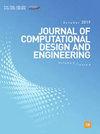建筑形式和生活形式的演变叙事
IF 6.1
2区 工程技术
Q1 COMPUTER SCIENCE, INTERDISCIPLINARY APPLICATIONS
引用次数: 0
摘要
自史前时代以来,建筑设计中的形式概念就一直存在争议。在最直接的意义上,形式可以定义为结构的形状、外壳和居住体积。本研究旨在探讨形式的变迁与演化的历史过程,并透过分析发现形式的新意义与潜力,发展对形式的批判视角。该研究围绕三个主轴进行。在第一阶段,设计一个地图来分析历史上形式的演变。这种映射着重于形式、设计和制作技术方法的变化。这一阶段揭示了形式不再仅仅是由图纸或静态生产的最终产品,而是一个概念,无论是在设计还是生产中,都涉及到时间-空间维度的过程和动态。在第二阶段,通过一个叫做“生命形态”的新概念来讨论形态的演变。形式代表静态或静止的东西,而生命形式则代表动态和流动的状态。形式是由设计师从上到下象征性地设计或生产的,而生命形式则是由参与设计或生产的行动者的影响而形成的自下而上的自主状态。随后,形式和重要形式之间的关系、过渡、相互作用和变化,以及它们的解释,在研究中提出的模型中进行了讨论,该模型基于从理论辩论中得出的概念集以及设计和制作过程中的含义。相信这种对建筑形式的探索和意识,将为当代对形式的理解、设计和制作实践带来新的维度。本文章由计算机程序翻译,如有差异,请以英文原文为准。
Mimari Formun Evrim Anlatısı ve Canlı Form Hali
The concept of form in architectural design has been debated since prehistoric times. In its most straightforward meaning, form can be defined as the shape, shell, and inhabited volume of a structure. This study aims to explore the historical process of the transformation and evolution of form, as well as to discover new meanings and potentials of form through analysis, and to develop a critical perspective on form. The study is structured around three main axes. In the first stage, a mapping is designed to analyze the evolution of form throughout history. This mapping focuses on the changes in the approach to form, design, and making techniques chronologically. This stage reveals that form is no longer merely a final product represented by drawings or statically produced, but rather a concept that involves process and dynamism in a temporal-spatial dimension, whether in its design or production. In the second stage, the evolution of form is discussed through a new concept called ‘vital form’. While form represents something static or stationary, vital form signifies a dynamic and fluid state. While form is symbolically designed or produced by the designer from top to bottom, vital form represents a bottom-up, autonomous state formed by the influence of actors involved in design or production. Subsequently, the relationships, transitions, interactions, and changes between form and vital form, as well as their interpretations, are discussed within the proposed model in the study, based on conceptual sets derived from theoretical debates and the implications in design and making processes. It is believed that such exploration and awareness of form in architecture will bring new dimensions to the contemporary understanding, design, and making practices of form.
求助全文
通过发布文献求助,成功后即可免费获取论文全文。
去求助
来源期刊

Journal of Computational Design and Engineering
Computer Science-Human-Computer Interaction
CiteScore
7.70
自引率
20.40%
发文量
125
期刊介绍:
Journal of Computational Design and Engineering is an international journal that aims to provide academia and industry with a venue for rapid publication of research papers reporting innovative computational methods and applications to achieve a major breakthrough, practical improvements, and bold new research directions within a wide range of design and engineering:
• Theory and its progress in computational advancement for design and engineering
• Development of computational framework to support large scale design and engineering
• Interaction issues among human, designed artifacts, and systems
• Knowledge-intensive technologies for intelligent and sustainable systems
• Emerging technology and convergence of technology fields presented with convincing design examples
• Educational issues for academia, practitioners, and future generation
• Proposal on new research directions as well as survey and retrospectives on mature field.
 求助内容:
求助内容: 应助结果提醒方式:
应助结果提醒方式:


